Heart Surgery Innovation: Y-Incision Annular Enlargement Procedure
Written By: Adam Pick, Patient Advocate, Author & Website Founder
Medical Expert: Bo Yang, MD, Cardiac Surgeon
Page Last Updated: June 3, 2025
New research suggests that patients needing heart valve replacement surgery may receive mechanical and/or tissue valves that are too small. As a result, the durability and the performance of the device may be compromised leading to early failure and patient reoperations.
For this reason, Dr. Bo Yang, a leading cardiac surgeon developed the Y-Incision Annular Enlargement Procedure. To learn more, we interviewed Dr. Yang about this new innovation in heart valve surgery.
Key Learnings: Y-Incision Annular Enlargement
Here are key learnings shared by Dr. Yang about the Y-Incision Annular Enlargement operation:
- The new Y-Incision Annular Enlargement Procedure was designed for patients diagnosed with severe aortic valve disease (e.g. aortic stenosis, aortic regurgitation, bicuspid aortic valve) who need an aortic valve replacement device implanted. “All patients who need aortic valve replacement with a normal annulus should have this procedure,” states Dr. Yang.
- New research suggests that implanted aortic valve replacement devices (mechanical and/or tissue valves) may be 5 to 7 millimeters smaller than the label. As a result, the durability and the performance of implanted devices may be compromised leading to survivability and quality-of-life challenges for patients. “The real opening of the artificial valve, including mechanical valve and the tissue valve, is smaller, much smaller than the label,” states Dr. Yang.
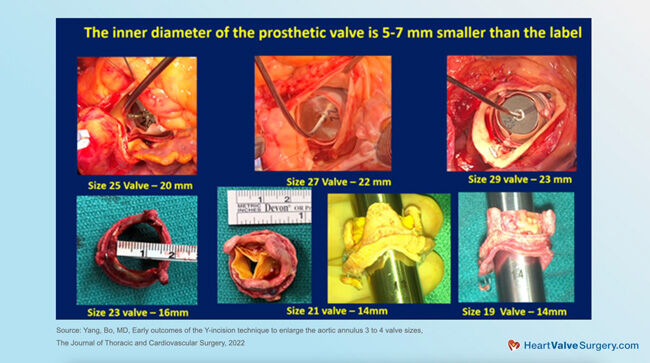
- During the Y-Incision Annular Procedure, Dr. Yang increases the annular size to “upsize” the heart valve replacement device by three to five sizes. “We size the aortic annulus in an inverted Y- fashion and when we enlarge the annulus. We can upsize the valves by three to five valve sizes and at the same time, enlarge the root.”
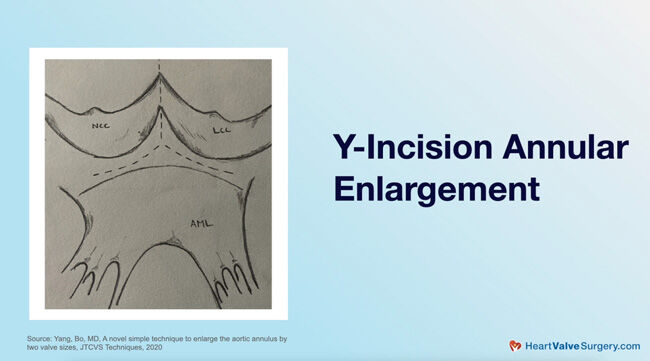
- The most common heart valve replacement device size implanted in the United States is a 23 size valve.
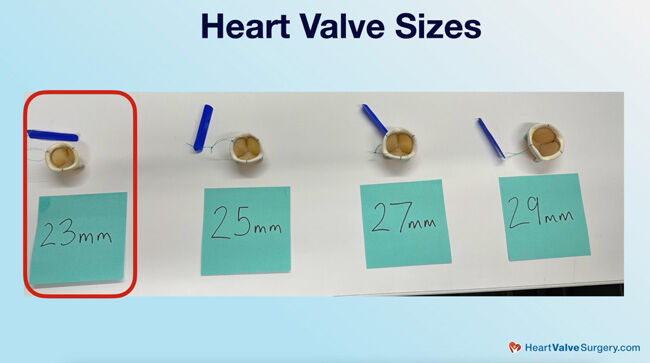
- However, after implant, the valve opening can be reduced by 40% to 60% which causes accelerated deterioration of the valve. Dr. Yang states, “That’s why small valves don’t last long. Because the aortic area is reduced by 40% to 60%. It won’t take too long for the valve to become stenotic. The patient doesn’t get the most benefit from the operation.”
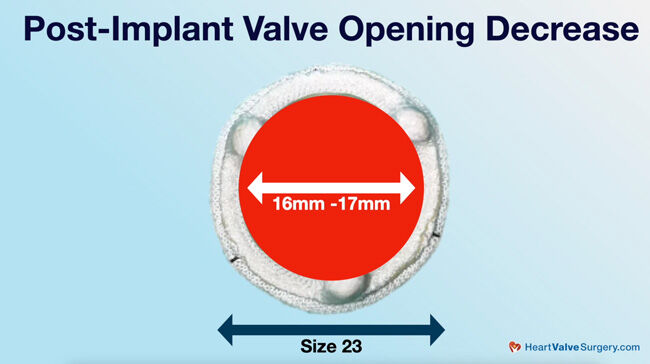
- The Y-Incision Annular Enlargement Procedure enables surgeons to “upsize” the valve replacement by three to five sizes. “We can upsize the valve by three to five sizes,” states Dr. Yang, “And, at the same time, enlarge the root.”
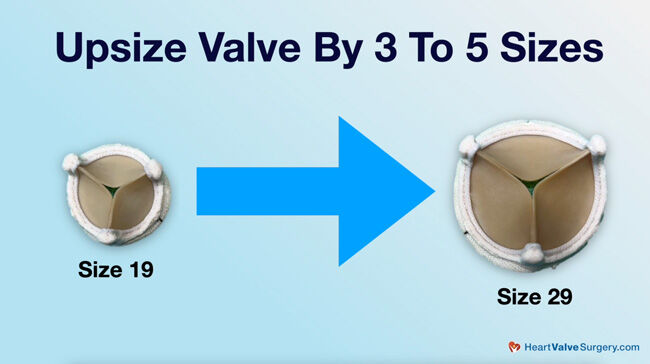
- Dr. Yang believes that by upsizing the valve, using the Y-Incision Annular Enlargement Procedure, the “biological clock” of the aortic valve is turned back. “We do the enlargement. We give the patient a 29 valve – which has the opening of about 23 or 24 matching the patient’s native annulus,” states Dr. Yang. “We basically turned the biological clock of the patient to when they were 19, 18 years old. We restore the normal anatomy of the opening, the anatomy of the aortic valve.”
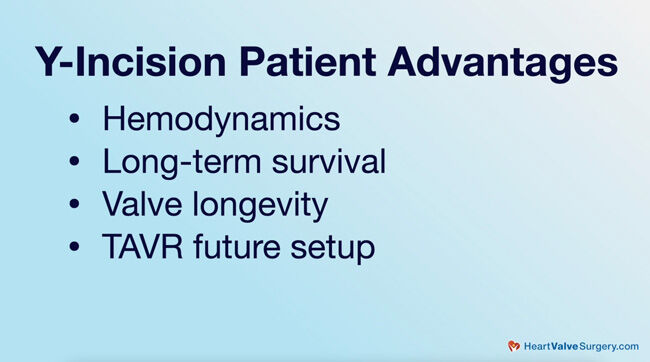
- The patient benefits of upsizing the valve with the Y-Incision Annular Enlargement Procedure includes enhanced hemodynamics, best long-term survival, improved longevity of the valve and a setup for future valve-in-valve TAVR procedures. Dr. Yang states, “Our interventional cardiologists love it because when they look at the anatomy of the valve enlargement. They say, ‘Wow, this is so easy for the valve-in-valve TAVR.'”
Why Don’t Heart Valve Manufacturers Address This Issue?
In response to this post, John, a patient in our community, had several great follow-up questions. John emailed me, “Why would the valve manufacturers already know this issue of the inner size being smaller than the outer size. With this already being known at the time of manufacture, why would it not already be addressed? Or perhaps there is a good reason not to mess with the original design?”
After reviewing these questions, Dr. Yang quickly emailed me the following response:
“When a prosthetic valve is made, it has to have struts to hold the valve cusps and sewing ring for surgeons to implant the valve to the heart. Those structures occupy spaces in the aortic root when the valve is implanted. The valve companies have been trying their best to make the low- profile valves, which means minimizing the extra-material (struts, sewing ring) as much as possible to maximize the opening of the prosthetic valve. The Y-incision is not to change the design or manufacture of the prosthetic valves perse, which are already made, rather than to put much larger prosthetic valves in patients for all the benefits we discussed in the video. The most used valve is size 23 valve in the US. The most common valve we use now is size 29 valve which has an opening matching the opening of the patient’s aortic valve when it was normal.” — Dr. Yang
Y-Incision Procedure for Mitral Valve Patients?
We also received many patient questions about whether-or-not the Y-Incision Annular Enlargement Procedure could be used to “upsize” mitral valve replacements. For example, Mike asked, “Hi Adam, Have doctors been working on the Y-Incision Procedure for mitral valve patients as it seems to only be limited to the aortic valve?”
In response to this question, Dr. Yang replied:
“The Y-Incision Aortic Annular Enlargement is designed to enlarge the aortic annulus and aortic root to put in a larger valve for aortic valve replacement. It is not designed for mitral valve disease. However, it does avoid cutting into the mitral valve as conventional aortic annular enlargement techniques do. It can used in the combination of mitral valve repair or replacement. This is a huge advantage of Y-incision technique.” — Dr. Yang
Many Thanks Dr. Bo Yang & Michigan Medicine!
Many thanks to Dr. Bo Yang for taking the time to share his clinical experiences and new research with our patient community.
Related Link:
Keep on tickin!
Adam
P.S. For the deaf and hard of hearing members of our community, I have provided a written transcript of my interview with Dr. Yang below.
Video Transcript:
Adam Pick: Hi, everybody, it’s Adam with heartvalvesurgery.com and we are at the American Association for Thoracic Surgery Conference in Los Angeles, California. I’m thrilled to be joined by Dr. Bo Yang who is a leading cardiac surgeon at Michigan Medicine in Ann Arbor, Michigan. Dr. Yang, thanks so much for being with us today.
Dr. Yang: My pleasure.
Adam Pick: Yeah, so we’ve got to talk. I’m real excited to learn all about the Y Incision Annular Expansion Procedure. Before we talk about this, who would this procedure – of the patients in our community, who might benefit from this?
Dr. Yang: Oh, that’s a great question. All patients who need a aortic valve replacement from whatever reasons such as aortic stenosis, aortic insufficiency, infarction of the aortic valve, which destroys the aortic valve and that the integers is normal, it’s not dilated, we cannot feed the larger valve, should have this procedure.
Adam Pick: Great, so patients might be wondering, what is the procedure and why did you create it?
Dr. Yang: Yeah, the procedure is called the Y-Incision Annular Enlargement. Basically, we incise the aortic annulus in an inverted Y fashion and we enlarge the annulus. We can upsize the valves by three to five valve sizes and at the same time, enlarge the root. Why will a patient need this procedure? Because this does add the operative time and challenge and complexity to the operation. The reason for that is we find out the real opening of the artificial valve, including mechanical valve and the tissue valve, is smaller, much smaller than the label.
For example: the most common valve used in the United States is size 23. It doesn’t mean this valve has an opening of 23. After we put the valve in, the opening of the valve is about 16, 17 millimeters, which reduce the annular area by 40% to 60%. That’s why those small valves don’t last long. Because, you already reduce the area by 40 to 60%. It won’t take too long become stenotic. The patient doesn’t get the most benefit from the operation.
Instead, we can first say the patient has 23 annulus. We do the enlargement. We give the patient a 29 valve, which has the opening of about 23, 24, match the patient native annulus. We basically turned the “biological clock” to the patient when they were 19, 18 years old with normal aortic valve. We restore the normal anatomy of the opening, the anatomy of the aortic valve. That’s why give the best hemodynamic outcome, best long-term survival and also improve the longevity of the valve and the great set of future valve-in-valve TAVR.
Adam Pick: I love the fact that you’re turning the biological clock back on the aortic valve. I love that the patients are getting advantages for hemodynamics, longevity, survivability, and you brought up the fact that you’re setting up the patients for the lifetime management of their valve disease for a potential TAVR down the road using, I’m guessing a “valve-in-valve” technique?
Dr. Yang: Yeah, because the annular enlargement enlarge the root too. We did a CT study of this procedure. We found out that the coronary distance from the valve is actually very adequate and that the aorta is wide open. Those are the critical measurements for the valve-in-valve TAVR. Our interventional cardiologists love it because they look at the anatomy of the valve enlargement. They say, “Wow, this is so easy for the valve-in-valve TAVR.” It’s very good for patients in the future when the valve goes down, say, 20 years and it’s very easy just to do a minimally-invasive valve-in–valve TAVR and avoid another sternotomy.
Adam Pick: I’ve thought about you working directly with the interventional cardiologist down the road and it’s just one more advantage of the Y Incision Procedure. Dr. Yang, on behalf of our community, patients all over the world, thanks for all the great work that you and your team are doing at Michigan Medicine in Ann Arbor, Michigan. Thanks so much for being with us today.
Dr. Yang: Thank you for having me. I think any of the patients deserve the best care.





